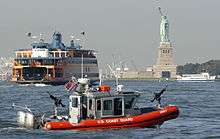Defender-class boat
 Defender-class boat | |
| Class overview | |
|---|---|
| Name: | Defender class |
| Builders: | SAFE Boats International |
| Operators: | |
| Subclasses: |
Defender "A" Class Defender "B" Class Defender "C" Class |
| In service: | 2002–Present |
| Completed: | 800 |
| Active: | 800 |
| General characteristics | |
| Displacement: | 2.7 ton |
| Length: |
8.9 m (29 ft 2 in) (A Class) 9 m (29 ft 6 in) (B Class) |
| Beam: | 2.6 m (8 ft 6 in) |
| Draught: | 0.98 m (3 ft 3 in) |
| Propulsion: | 2 × Honda 4-stroke outboard engines, 225 hp (168 kW) each |
| Speed: | |
| Range: |
175 nmi (324 km) (A Class) 150 nmi (280 km) (B Class) |
| Complement: | 4 crew, 6 passengers |
| Armament: |
1-2 × M240B (A and B Class) 1 × M2HB, 2 × M240B (C Class) |
The Defender-class boat, also called Response Boat – Small (RB-S) and Response Boat – Homeland Security (RB-HS), is a standard boat introduced by the United States Coast Guard in 2002. The boats serve a variety of missions, including search and rescue, port security and law enforcement duties and replaces a variety of smaller non-standard boats.[5]
The design length of the hull is 25 feet and the boat is officially referred to as such. However, the overall length with engines mounted is approximately 29 feet (8.8 m). Powered by twin 225 hp (168 kW) outboard motors, they are capable of speeds in excess of 46 knots (85 km/h) and have a range of 150 to 175 nautical miles (324 km), depending on the class. The boat requires a minimum crew of two persons, but has a carrying capacity for 10 persons. The boat is easily trailerable and can be transported by a C-130 Hercules aircraft or truck.[6]
Although similar in appearance to a rigid-hulled inflatable boat, the Defender is actually an aluminum-hulled vessel, equipped with a rigid foam-filled flotation collar. The boats are built by SAFE Boats International (Secure All-around Flotation Equipped) of Bremerton, Washington, a vendor of government and law enforcement boats.[7][8]
Design
The Defender class utilizes a rigid deep-V hull constructed of marine grade aluminum. While similar in appearance to the sponson of a rigid-hulled inflatable boat the Defender's collar is actually made from rigid polyethylene foam. The boat is powered by two 225 horsepower (168 kW) outboard engines, usually Honda four-strokes though Mercury and Johnson engines have also been used. Tow bitts are fitted forward and aft which also serve as mounting points for M240B or M60 machine guns.[6]
Variants
A class

The Defender A class or Response Boat - Homeland Security (RB-HS) was the first version of the Defender class and entered service in 2002. Some A-class boats in service with the Maritime Security Response Team (MSRT) have gray collars instead of the more common orange.
B class
The Defender B-class, also known as the Response Boat - Small (RB-S) is a further development of the A class. First entering service in 2003 it has a slightly longer cabin, additional spotter windows aft, shock mitigating cabin seats, a smaller 105 gallon fuel tank, and various other minor changes. It is the most common of the three classes.[6][9]
C class

The Defender C class, sometimes known as the Response Boat Small - Charlie, is a modification of the B class and was designed as a replacement for the aging 25-foot (7.6 m) Transportable Port Security Boats (TPSB) currently used by Port Security Units. The C class has a gray foam collar, a cabin climate control system, and an increased armament of one M2HB .50-caliber machine gun on a modified forward mount and two M240B machine guns on port and starboard mounts just aft of the cabin. The first C-class boats were delivered to Port Security Unit 305 in May 2008 for testing and entered operational service at Naval Station Guantanamo Bay, Cuba in 2009.[10]

Service Life and Replacement
With the Defender-class boats nearing the end of their 10-year service life, the Coast Guard issued a request for proposal for replacement design for the Response Boat-Small. The request called for a 25–30 foot boat, with weapon mounts, a minimum speed of 40 knots, and a range of at least 150 nautical miles.[11]
Contracts were awarded for two boats, one from SAFE Boats International and one from Metal Shark Aluminum Boats, for testing and on September 26, 2011 the Coast Guard awarded a contract to Metal Shark Aluminum Boats for the production of 38 Response Boats-Small.[12]
See also
References
- 1 2 "Bangladesh Navy surges ahead with massive expansion - Bangladesh Military Forces - BDMilitary.com". Bangladesh Military Forces - BDMilitary.com.
- ↑ Keeter, Hunter C. (November 2008). "Iraqi Navy's Boat Purchase Marks Milestone for Coast Guard FMS Program" (PDF). Delivering the Goods. United States Coast Guard.
- ↑ http://www.liberianobserver.com/node/10592 US Equip AFL with 2 Boats
- ↑ "Archived copy". Archived from the original on 2014-04-03. Retrieved 2013-12-11.Ships of the Nigerian Navy
- ↑ "25-Foot Defender Class Boat (RB-HS/RB-S)". United States Coast Guard. Retrieved December 13, 2008.
- 1 2 3 Defender Class Operator's Handbook (PDF) (Report). U.S. Department of Homeland Security, United States Coast Guard. June 27, 2006.
- ↑ "SAFE Boats International". SAFE Boats International LLC. Retrieved November 11, 2006.
- ↑ "GSA Sales page for SAFE Boats International". United States Government. Retrieved April 18, 2008.
- ↑ "Defender Class Boat (RB-HS/RB-S/RB-S II)". United States Coast Guard.
- ↑ http://www.jtfgtmo.southcom.mil/wire/wire/WirePDF/v9/Issue%2049v9.pdf The Wire Vol 9, Issue 49
- ↑ Johnson, Linda M. (September 2010). "Coast Guard Releases Request for Proposal for New Response Boat-Small" (PDF). Delivering the Goods. 31. United States Coast Guard. p. 2.
- ↑ "Contract Awarded for the Production of 38 Response Boats-Small" (Press release). United States Coast Guard. September 28, 2011.
External links
| Wikimedia Commons has media related to USCG Defender class boat. |